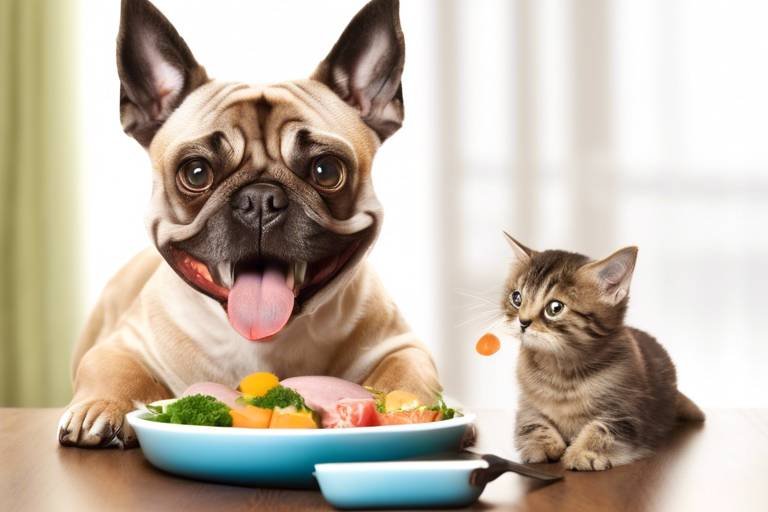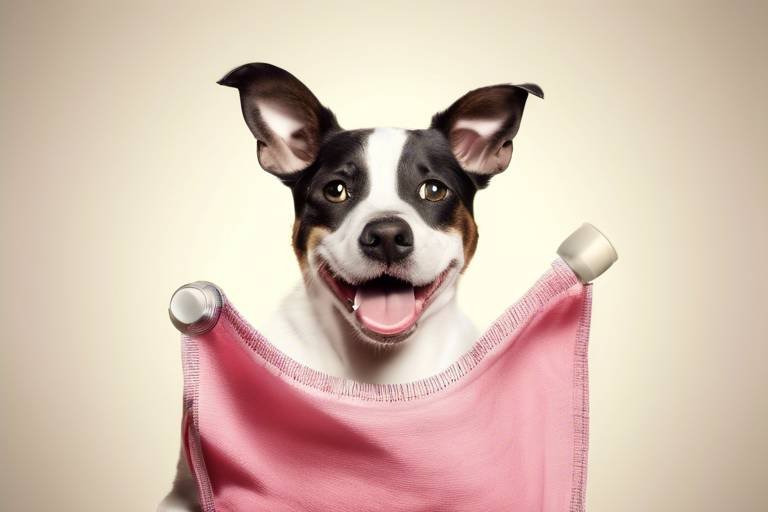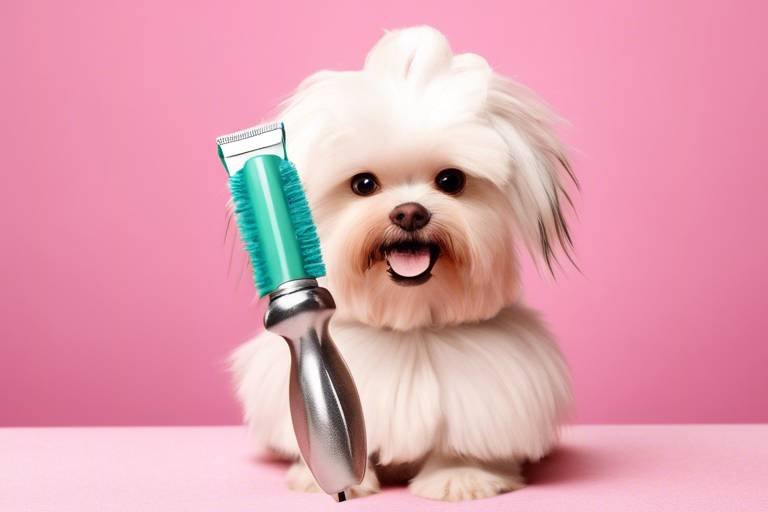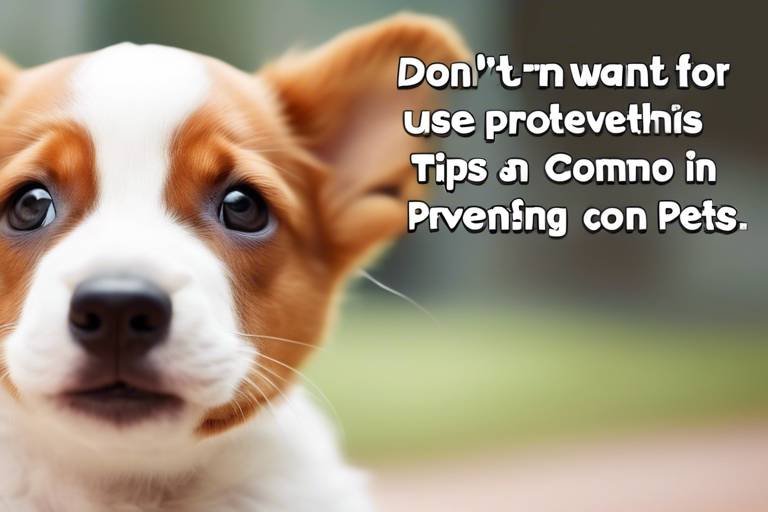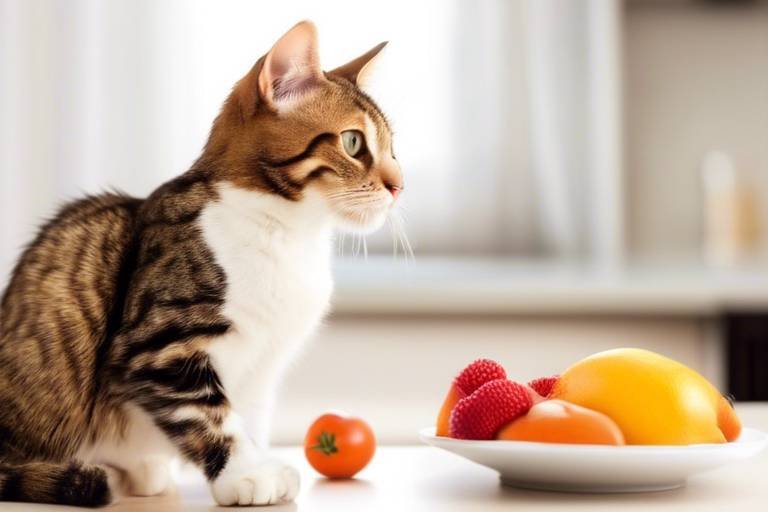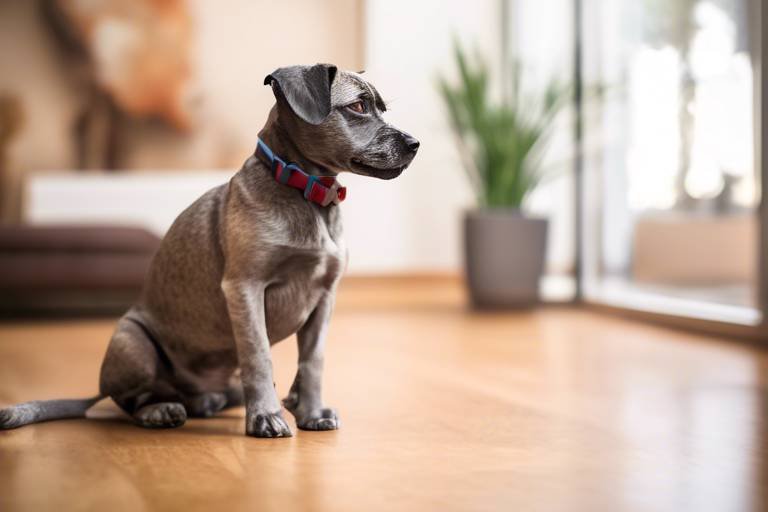How to Help Your Pet Adjust to a New Routine
Transitioning your pet into a new routine can feel like a daunting task, but with the right strategies, you can make it a smooth journey for both of you. Just like us, pets thrive on consistency and predictability. Imagine how unsettling it would be for you if your daily routine suddenly changed without notice! That's exactly how your furry friend might feel when faced with a new schedule. So, what can you do to ease this transition? In this article, we’ll explore practical strategies that will not only help your pet adjust but also strengthen the bond you share.
Recognizing the specific needs of your pet is crucial during a transition. Each pet has its own personality, quirks, and preferences. By taking the time to observe and interpret your pet's behavior, you can tailor your approach effectively. For instance, does your dog seem anxious when you leave for work? Or does your cat hide when you change their feeding schedule? These behaviors are signals that can guide you in making necessary adjustments. Pay attention to their body language, vocalizations, and even their eating habits. Understanding these cues will enable you to provide the support they need during this period of change.
Establishing a consistent daily routine can significantly benefit your pet’s adjustment. Just like children, pets feel more secure when they know what to expect. Regular feeding, walking, and playtime schedules foster a sense of security and stability. Imagine your pet's relief when they know exactly when it's time for their favorite activities! This predictability helps reduce anxiety and promotes a happier, healthier pet. Here’s how you can create that all-important routine:
Regular feeding times help pets anticipate meals, which can reduce anxiety. Think about it: when you know lunch is at noon, you can plan your day around it. The same goes for your pet! Maintaining a strict feeding schedule not only aids in digestion but also reinforces their trust in you. Aim to feed your pet at the same times each day, and soon enough, they’ll be looking at the clock, waiting for their meal!
Selecting appropriate food is essential for your pet's health. A well-balanced diet is key to your pet's overall well-being and can significantly impact their energy levels and mood. Consult with your veterinarian to determine the best diet for your pet’s age, size, and health needs. This can make a world of difference in how they adapt to a new routine. After all, you wouldn’t want to start a new exercise regime on an empty stomach, right?
Proper portion control ensures your pet maintains a healthy weight. Overfeeding can lead to obesity and health issues, while underfeeding can leave them feeling unsatisfied and anxious. Here are a few strategies for managing portions:
- Use measuring cups to ensure accurate portions.
- Divide meals into smaller, more frequent feedings if necessary.
- Limit treats to special occasions to maintain a balanced diet.
By keeping an eye on portion sizes, you're not just feeding your pet; you're investing in their long-term health.
Incorporating regular exercise is vital for your pet's physical and mental health. Think of exercise as the equivalent of a daily coffee for your pet—it's their way of waking up and getting energized for the day ahead! Tailor an engaging exercise routine to your pet's specific needs. For dogs, daily walks, playtime in the yard, or trips to the dog park can work wonders. Cats, on the other hand, might prefer interactive play sessions with toys that stimulate their hunting instincts. The key is to keep it fun and varied!
Creating a comforting environment can ease the transition for your pet. Just like you might want your favorite blanket or a cozy corner during a stressful time, your pet also craves comfort. Here are some ways to make your pet feel secure in their new routine:
Designating safe spaces in your home can help your pet feel secure. These areas should be quiet, comfortable, and away from the hustle and bustle of daily activities. Consider setting up a cozy bed in a corner or a crate that they can retreat to when they need a break. This safe haven will serve as their sanctuary during times of stress.
Keeping familiar items, like toys or blankets, can provide comfort. Just as a childhood toy can evoke feelings of nostalgia, your pet's favorite items can have a similar effect. These recognizable objects can help ground them in their new routine and provide a sense of normalcy. So, don’t be quick to pack away those old toys; they might just be the key to your pet's happiness!
Q: How long does it typically take for a pet to adjust to a new routine?
A: The adjustment period can vary widely depending on the pet and the changes made. Generally, it can take anywhere from a few days to several weeks for pets to fully adapt.
Q: What should I do if my pet shows signs of anxiety during the transition?
A: If your pet displays anxiety, try to maintain their routine as closely as possible. Providing comfort items and safe spaces can also help. In severe cases, consult your veterinarian for advice.
Q: Are there any specific foods that can help with my pet's anxiety?
A: Some pet foods are formulated with calming ingredients like L-Theanine or tryptophan. Always consult your veterinarian before making significant changes to your pet’s diet.

Understanding Your Pet's Needs
When it comes to helping your furry friend adjust to a new routine, the first step is to truly understand their needs. Just like us, pets have their own unique personalities and preferences that shape how they react to changes in their environment. Observing your pet's behavior closely can provide valuable insights into what they might be feeling during this transition. Are they more anxious than usual? Do they seem withdrawn or overly clingy? These signs can indicate that your pet is struggling to adapt, and it’s your job to help them through it.
One effective way to gauge your pet's emotional state is to look for changes in their usual habits. For instance, if your dog suddenly refuses to eat or your cat hides away more than normal, these could be red flags. Paying attention to their body language is equally vital; a wagging tail can mean happiness, while flattened ears might signal fear or discomfort. By tuning into these cues, you can better tailor your approach to meet their needs during this critical time.
Moreover, consider the specific needs of different types of pets. Dogs, for example, are social creatures that thrive on routine and companionship. They may need more interaction and reassurance from you as they adjust. On the other hand, cats tend to be more independent but can also be sensitive to changes in their environment. They might require a bit more patience and space to feel comfortable. Understanding these differences can help you create a supportive atmosphere for your pet.
Furthermore, establishing a consistent communication style with your pet can significantly ease their anxiety. Use a calm and reassuring tone when talking to them, and don’t forget to reward positive behavior with treats or affection. This not only builds trust but also reinforces the idea that change can be a good thing. Remember, your pet looks to you for guidance; your actions and demeanor can set the tone for how they perceive their new routine.
In summary, understanding your pet's needs is about more than just observing their behavior; it’s about creating a bond based on trust and communication. By recognizing their emotional cues and adapting your approach, you can help your pet navigate this transition smoothly. After all, a happy pet means a happy owner!
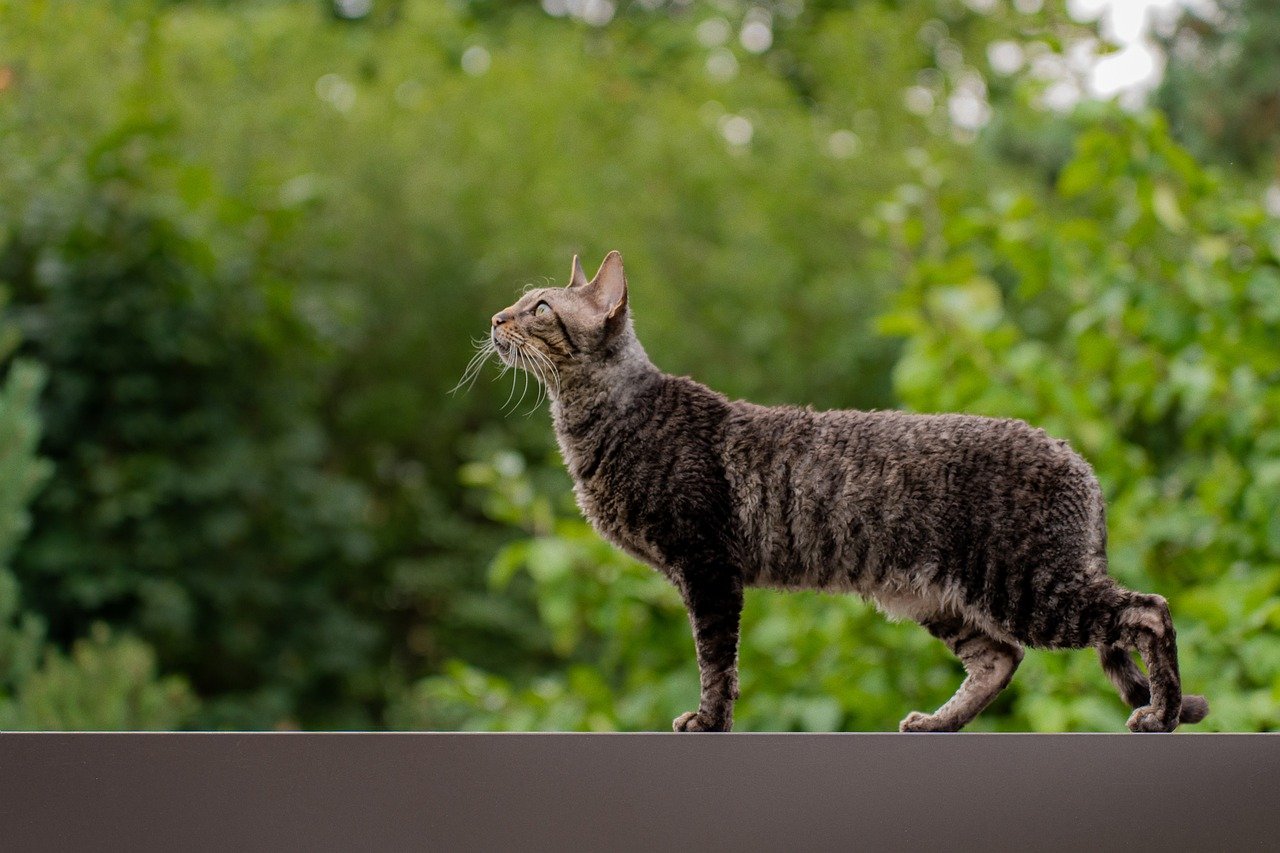
Creating a Consistent Schedule
Establishing a consistent daily routine is like laying down the tracks for a train; it guides your pet smoothly through the day, making them feel secure and comfortable. Imagine how chaotic life would be if you didn’t know when your next meal or playtime would be! Pets thrive on predictability, and having a set schedule helps reduce their anxiety during what can be a stressful transition. By implementing a routine that revolves around regular feeding, walking, and playtime, you can create a sense of normalcy that your pet will appreciate.
Think about it: when you wake up at the same time every day, your body gets used to it, right? The same goes for our furry friends. A consistent schedule means they know what to expect, which in turn helps them feel more at ease. For instance, if you feed your dog at 8 AM every morning, they’ll start to anticipate that time and feel more relaxed knowing their basic needs are being met. This predictability can significantly enhance their emotional well-being during the adjustment period.
Regular feeding times are just one piece of the puzzle. You should also consider setting specific times for walks and play. A well-structured day might look something like this:
| Time | Activity |
|---|---|
| 7:30 AM | Morning Walk |
| 8:00 AM | Breakfast |
| 10:00 AM | Playtime |
| 12:00 PM | Afternoon Walk |
| 6:00 PM | Dinner |
| 8:00 PM | Evening Playtime |
By following a schedule like this, you not only meet your pet’s physical needs but also provide them with mental stimulation and emotional comfort. Each activity reinforces their sense of security, making the transition smoother for both of you.
Now, let’s talk about the importance of flexibility. While consistency is key, it’s also essential to remain adaptable. Life can throw curveballs, and sometimes you might need to adjust your schedule. However, try to maintain the overall structure to keep your pet from feeling unsettled. If you know you’re going to be out late one evening, perhaps adjust the feeding time slightly earlier to accommodate your pet’s needs. It’s all about finding that balance between routine and flexibility.
In conclusion, creating a consistent schedule is a fundamental step in helping your pet adjust to a new routine. By establishing regular feeding, walking, and playtimes, you’re not just filling their day with activities; you’re providing them with a framework that fosters comfort and security. Remember, the more predictable their world is, the more at ease they will feel. So grab that calendar, jot down a plan, and watch your pet thrive in their new routine!
Feeding Times
When it comes to helping your pet adjust to a new routine, play a pivotal role. Just think about it: if you were suddenly thrown into a new environment with no idea when your next meal would come, you'd feel a bit anxious, right? Pets are no different! They thrive on predictability, and having a consistent feeding schedule can significantly reduce their stress levels. By establishing a regular time for meals, you allow your furry friend to anticipate their next feast, creating a sense of security that makes the transition smoother.
So, what does a consistent feeding schedule look like? Ideally, you should aim for the same times every day. For instance, if you feed your pet at 8 AM and 6 PM, stick to those times religiously. This regularity not only helps your pet understand when to expect food but also aids in digestion and overall health. It’s like setting your internal clock—once your pet gets used to it, they’ll be waiting by their bowl like clockwork!
Another important aspect to consider is the type of food you’re providing. Different pets have different nutritional needs, and ensuring they receive the right diet at the right time is crucial. High-quality food will not only satisfy their hunger but also fuel their energy levels and contribute to their overall well-being. If you're unsure about the best food for your pet, consulting with a veterinarian can provide tailored recommendations that suit your pet's specific needs.
Now, let’s talk about portion control. It’s easy to overindulge our pets, especially when those big, pleading eyes look up at you. However, maintaining a healthy weight is essential for your pet's long-term health. You can create a simple feeding chart to help manage portions effectively. Here’s a basic example:
| Pet Type | Daily Food Amount |
|---|---|
| Small Dog (up to 20 lbs) | 1/2 to 1 cup |
| Medium Dog (20-50 lbs) | 1 to 2 cups |
| Large Dog (over 50 lbs) | 2 to 4 cups |
| Cat | 1/2 to 1 cup |
By measuring out their food according to their size and dietary needs, you’ll help prevent obesity and related health issues. Additionally, try to avoid giving too many treats, especially during the adjustment phase. Treats should be used sparingly and as rewards for good behavior, rather than as a substitute for meals.
In conclusion, establishing regular feeding times is not just about keeping your pet’s tummy full; it’s about providing them with a sense of stability and comfort in a world that might feel a bit chaotic. Remember, a happy pet is a well-fed pet, and by sticking to a routine, you’re setting the stage for a smoother transition into your new lifestyle together.
- How many times a day should I feed my pet? Most pets do well with two meals a day, but this can vary based on age, size, and health needs. Always consult your vet for personalized advice.
- Can I change my pet's food abruptly? It's best to introduce new food gradually to avoid digestive issues. Mix the new food with the old over a week or so.
- What if my pet refuses to eat? If your pet consistently refuses food, consult a veterinarian to rule out any underlying health issues.
Choosing the Right Food
When it comes to ensuring your pet adjusts smoothly to a new routine, the importance of cannot be overstated. Just like us, pets thrive on a balanced diet that meets their specific needs. Imagine trying to focus on your new job with a growling stomach; your furry friend feels the same way when their meals don’t align with their nutritional requirements. So, how do you choose the best food for your pet? It starts with understanding their unique needs, which can vary based on factors like age, breed, size, and activity level.
First and foremost, consult with your veterinarian. They can provide tailored advice based on your pet’s health history and lifestyle. For instance, a high-energy puppy will have different dietary requirements than a senior dog who prefers a more sedentary lifestyle. Moreover, if your pet has any allergies or sensitivities, your vet can help you navigate through the maze of pet food options available in the market.
Next, let’s talk about the ingredients. When selecting food, look for high-quality, natural ingredients. This means avoiding fillers like corn and soy, which offer little nutritional value. Instead, focus on protein sources such as chicken, beef, or fish as the first ingredient. A quick tip is to read the label: if you can’t pronounce an ingredient, it’s probably best to steer clear of it. Additionally, consider foods that contain essential fatty acids, vitamins, and minerals, as these contribute to your pet’s overall health and help them adapt to their new routine.
Here’s a quick breakdown of what to look for in your pet’s food:
| Ingredient Type | Benefits |
|---|---|
| High-quality protein | Supports muscle development and energy levels |
| Whole grains | Provides energy and aids digestion |
| Fruits and vegetables | Rich in antioxidants and vitamins |
| Probiotics | Promotes gut health and boosts immunity |
Another crucial aspect of choosing the right food is portion control. Overfeeding can lead to obesity, which is a growing concern in pets today. To avoid this, follow the feeding guidelines provided on the pet food packaging, and adjust based on your pet’s individual needs. For instance, if your pet is less active than usual due to the new routine, you may need to decrease their food intake slightly. Keeping a consistent feeding schedule can also help regulate their appetite and prevent any anxiety related to mealtime.
Lastly, don’t forget to introduce any new food gradually. Abrupt changes can upset your pet’s stomach and lead to digestive issues. Start by mixing a small amount of the new food with their current food, gradually increasing the new food over a week or so. This will help your pet adjust without discomfort, making the transition smoother for both of you.
In summary, choosing the right food for your pet is a vital part of helping them adjust to a new routine. By consulting with your vet, focusing on high-quality ingredients, practicing portion control, and making gradual changes, you can ensure your furry friend stays healthy and happy during this transition.
- How do I know if my pet is getting the right nutrition? Look for signs like a shiny coat, healthy skin, and good energy levels. Regular vet check-ups can also help monitor their health.
- Can I feed my pet human food? Some human foods are safe, but many can be harmful. Always consult your vet before introducing any human food into your pet's diet.
- What should I do if my pet refuses to eat? If your pet suddenly stops eating, it could be a sign of stress or health issues. Consult your veterinarian if this persists.
Portion Control
When it comes to ensuring your pet's health, is paramount. Just like humans, pets can struggle with weight management, and improper feeding habits can lead to serious health issues. Imagine your furry friend as a car; if you don’t fuel it correctly, it won’t run efficiently. So, how do you make sure you’re giving them the right amount of food? First, it’s essential to understand the recommended feeding guidelines provided by your pet's food manufacturer. These guidelines usually consider your pet's age, weight, and activity level.
To keep things simple, consider using a measuring cup to portion out your pet's food. It’s easy to overestimate how much food they need, especially when they’re giving you those adorable puppy eyes. For example, if your dog requires one cup of food per meal, it's tempting to throw in a little extra "just in case." However, those extra bits can add up quickly, leading to unwanted weight gain. Instead, stick to the measured amount and observe how your pet responds. If they seem hungry after meals, it might be time to reassess the quality of the food rather than the quantity.
Additionally, managing treats is a crucial part of portion control. Treats can be a fantastic way to reward your pet, but they can also contribute significantly to their daily caloric intake. To avoid overindulging, try the following strategies:
- Limit treats to no more than 10% of your pet's daily caloric intake.
- Opt for healthier treats, like carrots or apple slices, instead of high-calorie snacks.
- Use a portion of their regular food as treats during training sessions.
Another effective method to control portions is to establish a feeding schedule. Instead of free-feeding, where food is available all day, try setting specific meal times. This approach not only helps with portion control but also creates a sense of routine for your pet, which can be comforting during times of transition. Just like you wouldn’t want to eat dinner at random hours every day, your pet thrives on consistency.
Finally, it’s worth noting that monitoring your pet's weight regularly is essential. Keep an eye on their body condition and adjust portions as necessary. If you notice that your pet is gaining weight, it might be time to cut back a little. Conversely, if they seem too thin, you may need to increase their portions slightly. Always consult your veterinarian if you're unsure, as they can provide tailored advice based on your pet's specific needs.
Exercise Routines
Incorporating regular exercise into your pet's daily routine is not just a good idea; it's a necessity for their overall well-being. Just like humans, pets require physical activity to stay healthy and happy. Imagine your furry friend as a balloon; without the right amount of air (or in this case, exercise), they can become deflated and lose their spark! So, how do you ensure your pet gets the right amount of exercise? Let's dive into some engaging ways to create an exercise routine that suits your pet's needs.
First off, it's essential to understand your pet's energy levels and preferences. Some pets are natural athletes, while others may prefer a more leisurely stroll. For instance, a high-energy dog like a Border Collie may thrive on vigorous activities such as running or agility training, whereas a more laid-back breed like a Bulldog might enjoy short walks and gentle play. Tailoring the exercise routine to fit your pet's personality is crucial. You wouldn't want to take a couch potato to a marathon, right?
Here are some effective strategies to keep your pet active:
- Daily Walks: Aim for at least one or two walks a day. This not only provides physical exercise but also mental stimulation as your pet explores new scents and sights.
- Interactive Play: Engage your pet with toys that encourage movement, such as fetch balls or laser pointers for cats. This can turn exercise into a fun game!
- Obstacle Courses: Set up a mini obstacle course in your backyard or living room. Use furniture, toys, and other items to create challenges that stimulate both body and mind.
Additionally, consider incorporating some structured activities:
| Activity | Duration | Benefits |
|---|---|---|
| Walking | 30-60 minutes | Improves cardiovascular health and strengthens muscles. |
| Fetch | 15-30 minutes | Enhances agility and provides mental stimulation. |
| Agility Training | 20-40 minutes | Builds confidence and strengthens the bond between pet and owner. |
It's also essential to monitor your pet's response to the exercise routine. Are they panting excessively? Are they showing signs of fatigue? It's crucial to adjust the intensity and duration of the activities based on their comfort level. Just like a good workout for us, we can't push our pets beyond their limits. Remember, the goal is to create a positive association with exercise, so keep it fun and rewarding!
Finally, don't forget to include some rest days in your pet's routine. Just like humans need time to recover after a workout, pets also benefit from downtime to recharge. This balance between exercise and rest will ensure that your pet remains healthy and eager for their next adventure. So, get out there, grab a leash or a favorite toy, and make exercise an enjoyable part of your pet's new routine!
Q: How much exercise does my pet need?
A: The amount of exercise varies by species, breed, and age. Generally, dogs need at least 30 minutes to 2 hours of exercise daily, while cats may require less but still benefit from interactive play.
Q: What if my pet is overweight?
A: Consult your veterinarian for a tailored exercise and diet plan. Gradual increases in activity can help your pet lose weight safely.
Q: Can I exercise my pet indoors?
A: Absolutely! Indoor activities like fetch, tug-of-war, or even training sessions can provide great exercise when outdoor options are limited.
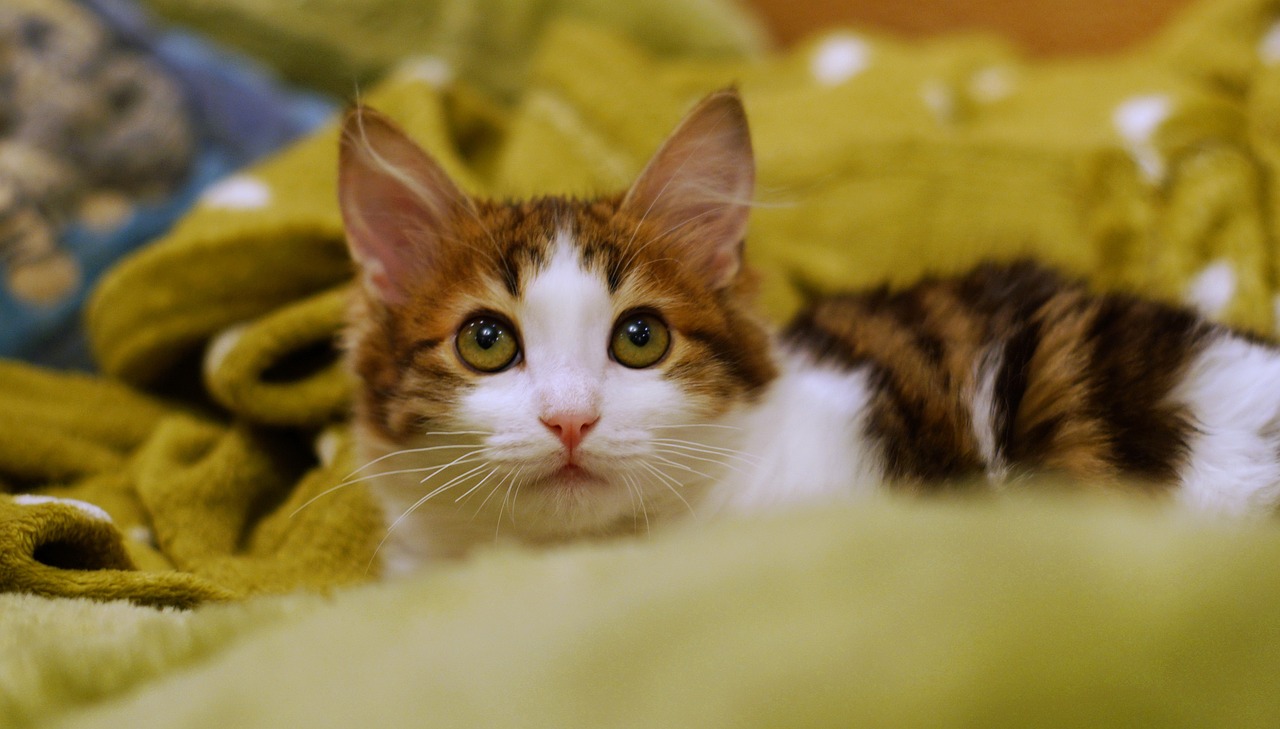
Providing Comfort and Security
When it comes to helping your pet adjust to a new routine, one of the most important aspects is providing them with a sense of comfort and security. Just like us, pets thrive in environments where they feel safe and loved. Imagine moving to a new house without any familiar items around; it can be overwhelming! This is why creating a nurturing space for your furry friend is essential. A little effort can go a long way in making your pet feel at home.
First off, consider designating specific areas in your home as safe spaces for your pet. These should be quiet corners where they can retreat when feeling anxious or overwhelmed. Think of it as their personal sanctuary. You can use cozy blankets, cushions, or even a pet bed to make these spots inviting. It’s also important to keep these areas free from disturbances, allowing your pet to relax and recharge. A safe space can be a game-changer, especially during the initial days of adjusting to a new routine.
Another way to enhance your pet's comfort is by keeping familiar items nearby. Pets often find solace in their favorite toys, blankets, or even your old t-shirt. These items carry the scents and memories of their previous environment, providing a sense of continuity. When they see their beloved chew toy or snuggle into a familiar blanket, it can help reduce their anxiety levels significantly. It’s like having a piece of home with them wherever they go!
Moreover, consider the layout of your home. Is there a particular spot where your pet loves to hang out? Maybe it’s by the window where they can watch the world go by or near your feet while you work. Allowing them to have access to these areas can help them feel more secure and integrated into the family dynamic. Make sure these spots are easily accessible, especially during the transition period, so they can retreat there whenever they feel the need.
Lastly, don’t underestimate the power of your presence. Spending quality time with your pet can be incredibly reassuring. Engage in activities they love, whether it’s playing fetch, going for walks, or simply lounging together on the couch. Your attention and affection will communicate to them that they are safe and loved, which is invaluable during this adjustment phase.
- How long does it take for a pet to adjust to a new routine?
Adjustment periods can vary, but typically it takes a few weeks for pets to acclimate to a new routine. Be patient and observant of their behaviors during this time.
- What should I do if my pet seems anxious?
If your pet shows signs of anxiety, consider creating a safe space for them and providing familiar items. Additionally, consult your veterinarian for further advice.
- Can I help my pet adjust through training?
Yes! Positive reinforcement training can help your pet feel more secure and confident in their new routine. It also strengthens your bond with them.
Safe Spaces
When it comes to helping your pet adjust to a new routine, creating in your home is crucial. Think of these areas as your pet's personal sanctuary, where they can retreat to feel secure and comfortable amidst the changes happening around them. Just like us, pets can feel overwhelmed when faced with new situations, and having a designated spot to relax can significantly ease their anxiety.
To create a safe space, start by choosing a quiet area in your home that is away from the hustle and bustle of daily activities. This could be a cozy corner in the living room, a specific room, or even a designated area in your bedroom. Make sure it’s a place where your pet can feel protected and undisturbed. You can enhance this space by adding a comfortable bed or blanket, which will provide them with a familiar texture to snuggle into. Consider including some of their favorite toys or a piece of your clothing that carries your scent, as this can provide additional comfort.
Moreover, it’s essential to keep this area clean and free from distractions. Too much noise or movement can make it difficult for your pet to relax. If you have children or other pets, educate them about the importance of respecting this safe space. You might even want to use a sign or a simple visual cue to remind everyone to give your pet some alone time when they seek it.
Another effective way to enhance your pet's safe space is by incorporating calming elements. For example, you can use soft lighting or a white noise machine to create a soothing atmosphere. Some pets may also benefit from aromatherapy products designed for animals, such as calming sprays or diffusers that use essential oils known to help reduce anxiety. Always ensure that any products used are safe for pets, as some essential oils can be harmful.
Lastly, it’s vital to observe how your pet interacts with their safe space. Does your dog gravitate towards it when they feel anxious? Does your cat curl up in their bed when they need a moment of peace? Understanding their behavior will help you make necessary adjustments to ensure their safe space remains effective. Remember, the goal is to create a haven where your pet can feel secure, relaxed, and ready to face the world once again.
- What is a safe space for pets? A safe space is a designated area in your home where your pet can retreat to feel secure and relaxed, especially during times of change or stress.
- How can I make my pet's safe space more comfortable? You can make it comfortable by adding a cozy bed, familiar toys, and calming elements like soft lighting or soothing sounds.
- Should I encourage my pet to use their safe space? Yes, encouraging your pet to use their safe space can help them feel more secure. You can do this by rewarding them when they go to their designated area.
- What if my pet doesn't seem to use their safe space? If your pet isn’t using their safe space, try observing their behavior and making adjustments. Ensure the area is quiet, comfortable, and appealing to them.
Familiar Items
This article provides practical strategies and insights for pet owners to facilitate their pets' transition into a new routine, ensuring a smooth adjustment period for both pets and their owners.
Recognizing the specific needs of your pet is crucial during a transition. This section discusses how to observe and interpret your pet's behavior to tailor your approach effectively.
Establishing a consistent daily routine can significantly benefit your pet’s adjustment. Here, we explore the importance of regular feeding, walking, and playtime schedules for fostering security.
Regular feeding times help pets anticipate meals, reducing anxiety. This subheading delves into the benefits of maintaining a strict feeding schedule for your pet's well-being.
Selecting appropriate food is essential for your pet's health. This section discusses how to choose the right diet and its impact on your pet's routine adjustment.
Proper portion control ensures your pet maintains a healthy weight. Here, we outline strategies for measuring food and managing treats during the adjustment period.
Incorporating regular exercise is vital for your pet's physical and mental health. This section highlights how to create an engaging exercise routine tailored to your pet's needs.
Creating a comforting environment can ease the transition for your pet. This subheading discusses various ways to make your pet feel secure in their new routine.
Keeping familiar items, like toys or blankets, can provide comfort during a transition. Just imagine how you feel when you have your favorite blanket on a chilly night or your favorite mug for that morning coffee; it’s the same for our furry friends. These items serve as a tangible connection to their previous environment, offering a sense of security and stability amidst change.
When a pet encounters a new routine, the unfamiliarity can induce stress or anxiety. By surrounding them with familiar items, you can create a soothing atmosphere. For instance, if your dog has a favorite chew toy or your cat loves a particular blanket, having these items readily available can make a world of difference. They act as a comfort zone, allowing your pet to feel more at ease as they navigate the new changes.
Here are some examples of familiar items that can help:
- Toys: Chew toys, soft toys, or interactive toys that your pet loves.
- Blankets: Their favorite blanket or bedding that smells like home.
- Clothing: An article of your clothing can provide a sense of your presence when you’re not around.
Moreover, it’s essential to ensure that these items are clean and safe for your pet to use. Regularly check for wear and tear, and replace them as necessary to maintain a healthy and comforting environment. Remember, the goal is to make your pet feel at home, so the more you can incorporate their favorite things into their new routine, the better they will adjust.
- How long does it take for a pet to adjust to a new routine?
Every pet is different, but on average, it can take anywhere from a few days to a few weeks for pets to fully adjust to a new routine. - What if my pet seems stressed despite familiar items?
It's important to monitor their behavior closely. If stress persists, consider consulting a veterinarian or a pet behaviorist for tailored advice. - Can I introduce new items while my pet is adjusting?
Yes, but introduce them gradually. Too many changes at once can overwhelm your pet.
Frequently Asked Questions
- How can I tell if my pet is struggling with the new routine?
Pets may show signs of stress or anxiety when adjusting to a new routine. Look for behaviors such as excessive barking, hiding, changes in eating habits, or destructive actions. If your pet seems restless or overly clingy, it might be a sign that they need more time to adapt.
- What should I do if my pet refuses to eat after the routine change?
It's not uncommon for pets to lose their appetite during transitions. Try offering their favorite foods or treats to entice them. If they still refuse to eat after a couple of days, it’s best to consult your veterinarian to rule out any health issues.
- How long does it usually take for a pet to adjust to a new routine?
The adjustment period varies for each pet, depending on their personality and past experiences. Generally, it can take anywhere from a few days to several weeks. Patience and consistency are key during this time.
- Can I use training aids to help my pet adjust?
Absolutely! Training aids, such as clickers or treats, can reinforce positive behavior and help your pet learn the new routine. Positive reinforcement can make the transition smoother and more enjoyable for both of you.
- What are some comforting items I can provide for my pet?
Familiar items like their favorite blanket, toys, or even clothing that smells like you can provide comfort. These items can create a sense of security and help your pet feel more at home during the adjustment period.
- Is it important to maintain a consistent feeding schedule?
Yes! A consistent feeding schedule helps pets anticipate meal times, which can reduce anxiety. Regular feeding also contributes to better digestion and overall health, making it an essential part of their routine adjustment.
- How can I create a safe space for my pet?
Designate a quiet area in your home where your pet can retreat when they feel overwhelmed. This space should be comfortable, with their bed, toys, and some of your scent. It’s a sanctuary where they can feel secure and relax.
- What kind of exercise routine is best for my pet?
The best exercise routine depends on your pet’s breed, age, and energy level. Generally, a mix of walks, playtime, and mental stimulation activities like puzzle toys can help keep your pet physically and mentally engaged during the adjustment period.


